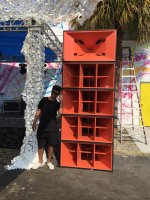It's a Folgertech FT-5 (kit printer), with modifications (hot end, extruder, bed, power supply, various printed pieces). Very nice printer when it's finally going but will eat up a big portion of your life getting it there!What printer do you have Bill?
Hi bill,
great project, I also printed some very basic parts for my unity horns.
What drivers are you going to use for this one?
They're the same drivers as in the SmallSyns (the Tymphany CD, Celestion tf0410, and FaitalPro 6FE100
Very nice project - Can't you extend the frame another foot so you could print the whole thing in one shot?
Possibly could, but
1) that would be another big project
2) where would I put it (the printer)? The FT-5 printer is already approaching unmanageable in size
3) there's an advantage in printing in sections, given the rapidly increasing likelihood for a print to fail the longer it takes. I would have to go find a liquor store if a 27 hour print jammed at 26 hours!
All loaded up. Gets to be a heavy sucker with all those magnets plastered onto it.
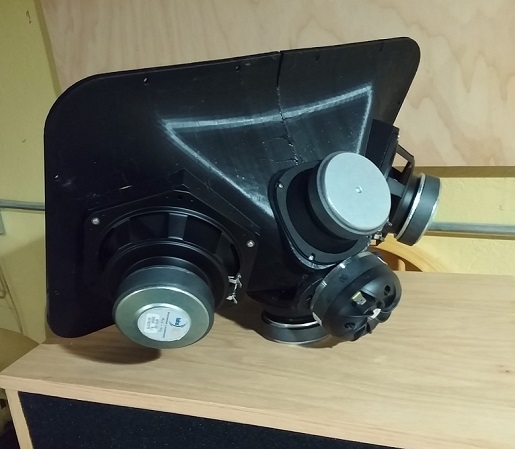
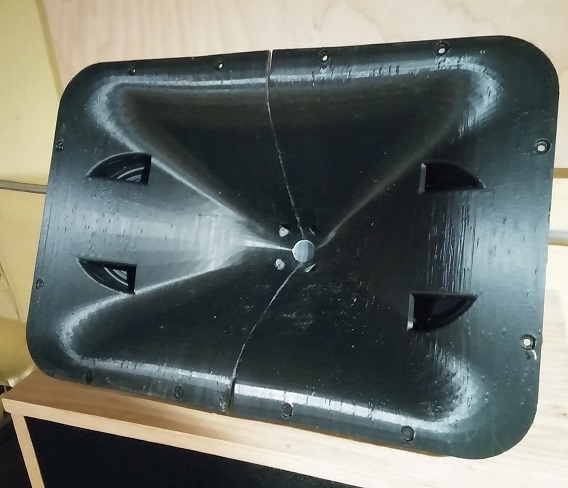
The response is different than I expected (midrange goes higher than I thought it would, which isn't a bad thing I guess). The woofers are with their backs open (no box), so not very meaningful other than the placement of the reflection notch.
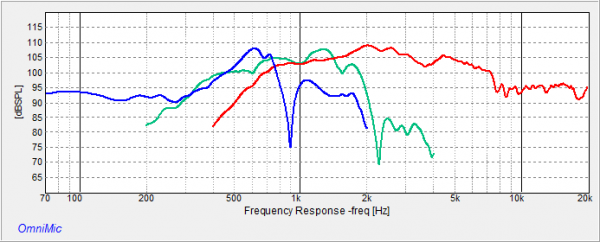


The response is different than I expected (midrange goes higher than I thought it would, which isn't a bad thing I guess). The woofers are with their backs open (no box), so not very meaningful other than the placement of the reflection notch.

Last edited:
Wish the response was less lumpy though. I was looking at the relatively crude HornResponse model I did for it to see what might be changed. The lumps and dips are mostly in different places (except the reflection notches), probably because of the different shape (rectangular rather than circular). It appears I could bring the high end up a bit more (to maybe make the biggest lump less prominent) if I give it a little more front volume. I think I'll print some small spacers to put on the front of the mids to see if that's the right direction to go. But right now, the printer is occupied making a Buddha statue of Homer Simpson! Gotta have priorities..
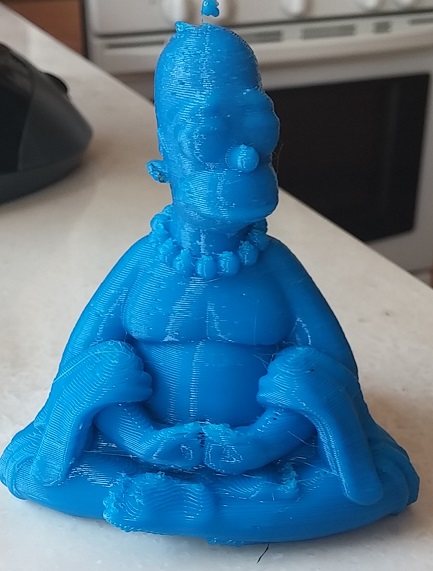
I could also try moving the port placement a little further from throat to try to bring up the low end (have to model that and see).

I could also try moving the port placement a little further from throat to try to bring up the low end (have to model that and see).
This is a great project, and very fun to follow.
What are your projected crossover points?
Looks like about 400Hz and 1400Hz.
Why again can't you use the SEOS 18 or 24 for a project like this, because wouldn't it allow you to do it as a 2 way with suitably capable drivers? I think you touched on it in your other thread and am wondering if you can add some more detail about what the downsides are.
Well, the main downside is that they cost quite a bit to iterate into a working arrangement and that they use larger tweeters (1.4" diameter) than I want to use. There is a version of SEOS18 that uses a 1" tweeter, but still, mounts for the midrange (or midranges) would need to be made and glued on. There is already the SmallSyns design that uses the molded and inexpensive SEOS15. And I want the woofers in the same line and at the right distance to do the 'array trick' that I use in the SmallSyns (which gets horizontal directivity to significantly lower frequencies than the horn itself has). A two-way won't work like that, nor would it have the acoustic distortion filtering that the midrange in a 3-way will. In the SmallSyns, the woofers had to be mounted behind and slightly below the waveguide but in these integrated printed ones, the woofers will be vertically centered on it.
Also, making my own waveguide allows me to use a larger vertical angle so that vertical directivity will be maintained to a lower frequency, largely eliminating the phenomenon of pattern flip -- SEOS horns were designed to be short in height so their centers can be close to a woofer mounted below, but synergy type horns are point source and can have larger expanse in the vertical. I might go with a square horn, except that I'd have to divide it in 4 to fit the pieces on my 3d printer for a big enough waveguide, and also I don't care a lot for their appearance.
Also, making my own waveguide allows me to use a larger vertical angle so that vertical directivity will be maintained to a lower frequency, largely eliminating the phenomenon of pattern flip -- SEOS horns were designed to be short in height so their centers can be close to a woofer mounted below, but synergy type horns are point source and can have larger expanse in the vertical. I might go with a square horn, except that I'd have to divide it in 4 to fit the pieces on my 3d printer for a big enough waveguide, and also I don't care a lot for their appearance.
Last edited:
Ain't it pretty?
Rev 3:
Have more than an octave of tweeter/mid overlap now
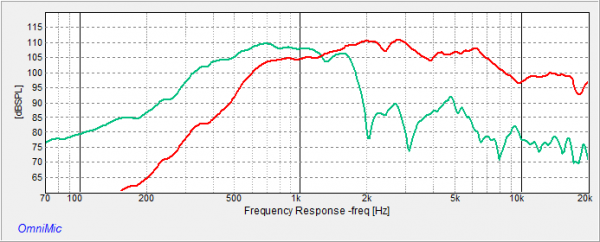
The tape over the edges is because I still had an adhesion problem (caused a warp on the outer edge) when one half of this was being printed, have that solved now. I also have bolt holes so that the two halves can be joined and aligned for accurate gluing. Ready to build a clean set now and start on crossover, and have mounting posts for it on the back of the waveguide. If all the parts fit, the waveguide will be a one-piece integrated assembly
Not real happy with the tweeter bumpiness though. I might try some other tweeters (CDX1-1445 and DNA360) to see if those work out better. The throat angle will match the CDX1.
Rev 3:
Have more than an octave of tweeter/mid overlap now

The tape over the edges is because I still had an adhesion problem (caused a warp on the outer edge) when one half of this was being printed, have that solved now. I also have bolt holes so that the two halves can be joined and aligned for accurate gluing. Ready to build a clean set now and start on crossover, and have mounting posts for it on the back of the waveguide. If all the parts fit, the waveguide will be a one-piece integrated assembly
Not real happy with the tweeter bumpiness though. I might try some other tweeters (CDX1-1445 and DNA360) to see if those work out better. The throat angle will match the CDX1.
Last edited:
- Home
- Loudspeakers
- Multi-Way
- 3D printing 1/2 of a waveguide


